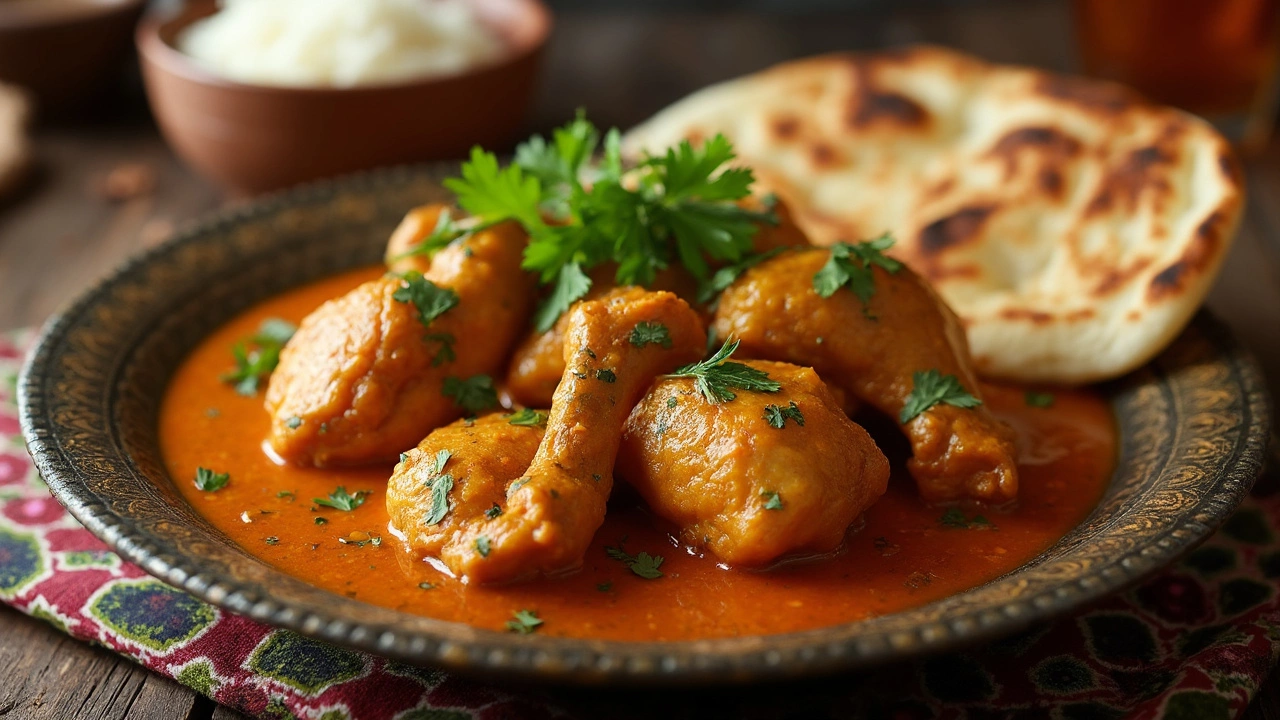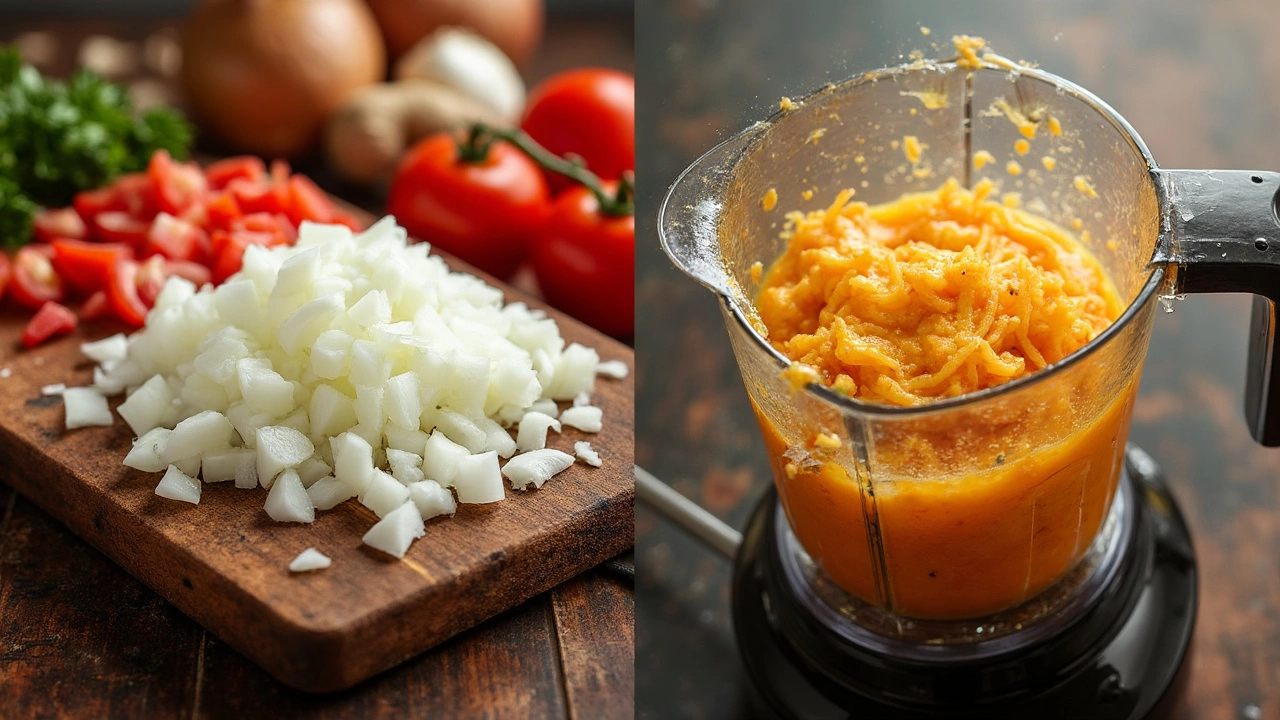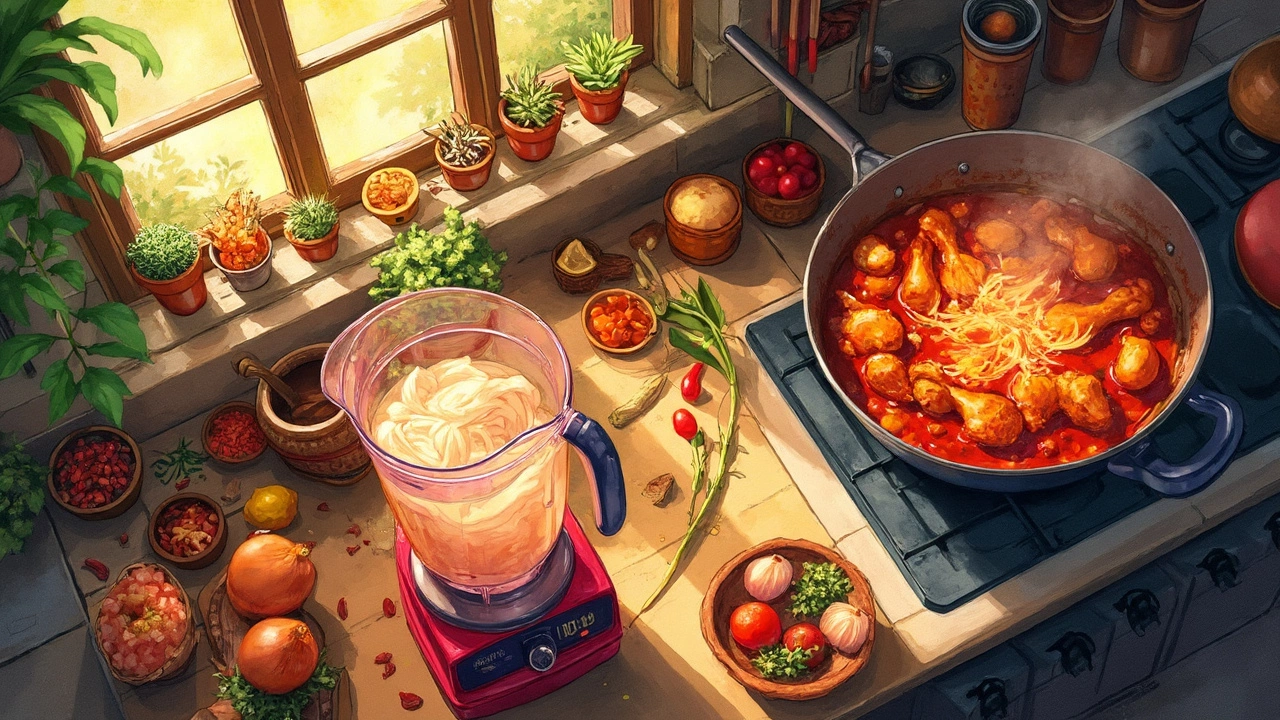So you're in the kitchen, staring at those onions, and thinking, should I blend them for my chicken curry? It's not as straightforward as it seems. Blending onions can work wonders in some recipes, but is it the right move for yours?
Blending onions changes things up by giving your curry a smooth texture and a subtly sweet flavor that chopped onions just can't replicate. It can transform your dish from chunky to velvety. But hold up, before you toss those onions into a blender, let's chat about when it's a game-changer and when it's a no-go.
If you're aiming for a creamy curry that gently coats your chicken, blending might be your best bet. The smoother texture can give off a more luxurious vibe, making the entire dish feel richer. Not to mention, blended onions cook down faster, letting those flavors meld without fuss.
- Why Blending Onions?
- Texture and Flavor Differences
- When to Blend and When Not To
- Practical Tips for Blending
- Alternatives to Blending
Why Blending Onions?
First off, blending onions isn’t just a trendy hack. It’s rooted in culinary wisdom. By blending, you break down onions into a smooth paste that serves as a powerhouse base for your chicken curry. This technique is popular in many Indian households for a reason.
When onions are blended, they release their natural sugars more evenly. This can give your curry that subtle, sweet undertone that perfectly balances spicy flavors. Blended onions also thicken the sauce nicely without needing extra cream or flour—a win if you’re looking for a healthier option.
The Chemistry at Play
The magic is in the chemistry. Blending onions creates more surface area, which means more opportunity for the Maillard reaction—where the onions brown and become flavorful. This can add a depth to your curry that chopped onions might not achieve.
Blending Time vs. Chopping Time
Think about the time, too. Chopping onions can be a teary, tedious affair. Blending is quicker and less messy, saving you some kitchen hustle. But make sure to sauté that onion paste long enough to cook off the raw, bitter notes and let those sweet flavors develop.
Here's a quick comparison:
| Method | Time | Effect on Curry |
|---|---|---|
| Chopped Onions | 5-10 minutes prep | Chunky texture, distinct onion taste |
| Blended Onions | Less than 5 minutes prep | Smooth texture, well-integrated flavor |
So, next time you’re prepping your curry recipe, give blending a whirl. It might just become your secret to that restaurant-quality taste at home!
Texture and Flavor Differences
Blending onions before tossing them into your chicken curry can lead to a whole new culinary experience. This simple twist plays a huge role in both texture and taste.
Smooth vs. Chunky
Blended onions give your curry a silky, even consistency which is perfect if you're aiming for a sauce that envelops each piece of chicken with ease. There's something satisfying about a smooth curry that coats your palate evenly, making each bite of chicken extra tender.
On the other hand, if you're all about the bite, chopped onions maintain that little bit of crunch and distinctive texture as they cook. This creates a chunkier curry that has more bites and layers of texture.
Flavor Dynamics
When it comes to flavor, blending onions tends to release their natural sugars faster. This means you'll get a slightly sweeter curry, which can be a delightful contrast to the spices. Blending also ensures a more uniform cooking of the onions, allowing their flavors to meld thoroughly with the spices and chicken.
Chopped onions, however, maintain their pungency longer, releasing flavors gradually. This gives your curry a punchier kick, especially if you like a bit more intensity in your dish.
Time-Saving or Not?
Cooking time can be affected too. Those blended onions will cook down faster, shortening the time it takes to get dinner on the table—a win if you’re in a rush. But if you love the layering of flavors that builds over slow cooking, chopping might be the way to go.
| Onion Form | Texture | Flavor Impact | Cooking Speed |
|---|---|---|---|
| Blended | Smooth | Sweeter | Faster |
| Chopped | Chunky | Strong | Slower |
Deciding between blending or chopping onions in your curry recipe is all about what you prefer in texture and taste. Each method offers its unique perks and knowing them can push your curry from good to downright amazing.

When to Blend and When Not To
Blending onions isn't always a one-size-fits-all trick for every chicken curry. It's about matching the method to the style you’re aiming for. Think of it like choosing the right tool for a job; both have their time and place in your cooking arsenal.
When to Go for the Blend
If you're crafting a chicken curry that’s meant to be creamy and uniform, blending is your friend. Blended onions can integrate seamlessly into sauces, giving a richer, cohesive flavor. They add a sweet touch that pairs well with spicy and aromatic ingredients.
Consider blending onions when:
- You want a smoother texture for gravy-based curries.
- You're aiming for a more homogeneous look and feel.
- Cooking time is short and you need onions to break down quickly.
When Not to Blend
On the flip side, sometimes you want a bit of texture in your dish to mix it up. Avoid blending if you’re going for a rustic or chunky style where visible onion pieces add depth.
Avoid blending onions when:
- You're making a curry that’s supposed to have some bite, like a stir-fry or sauté style.
- The recipe is meant to have a rustic appeal, showcasing individual ingredients.
- You’re using high heat where finely diced onions can caramelize nicely, adding a deeper flavor.
Understanding the Balance
It’s not just about the final taste and texture—it's also about cooking style. Remember, blending onions can sometimes mellow their potency. This is ideal when you want the flavors to intermingle rather than having the onion stand out.
Here's a quick tip: if you’re unsure, try blending half the onions and dicing the other half. This way, you maintain some texture while still enjoying the integrated flavor profile blended onions offer.
Practical Tips for Blending
Blending onions might sound simple, but getting the texture just right can make or break your chicken curry. To ensure those onions enhance rather than overpower your dish, let's go over some practical tips for the best results.
1. Choose the Right Onions
Not all onions are created equal when it comes to blending. Sweet onions can amp up the sweetness of your curry, while red onions add a depth that's unmistakable. For a classic curry flavor, yellow onions are your go-to.
2. Prep Before You Blend
- Peel and Chop First: Cut your onions into quarters to make blending quicker and more even.
- Sauté for Flavor: Lightly sautéing onions before blending can bring out their sweetness and reduce the harshness they sometimes have in their raw state. This step is key if you're worried about a strong onion taste.
3. Blender Techniques
To avoid ending up with onion juice rather than a paste, pulse the onions in short bursts rather than letting the blender run continuously. You want a creamy consistency that holds its shape, not a watery mess.
4. Mix with Other Ingredients
For a deeper flavor, consider blending onions with garlic and ginger. This combo can elevate your curry recipe to restaurant-quality. Adding a chili or two for a spicy kick? Blend them with the onions to disperse the heat evenly.
5. Mind the Cooking Time
Blended onions cook faster, so keep an eye out to prevent them from turning bitter. Once they reach a deep golden brown, you know you're in the golden zone!
With these tips, you're set to blend those onions like a pro and make your next chicken curry an absolute win. Happy cooking!

Alternatives to Blending
Okay, so maybe you're not all about that blender life when it comes to making your chicken curry. No worries! There are some cool, no-blend methods that still deliver on flavor and texture without you breaking a sweat.
Slicing and Dicing
Chopped or sliced onions can bring out a more rustic texture for your curry recipe. When you sauté them until they're golden brown, they add a bit of that perfectly uneven, home-cooked vibe. This technique is great if you're making something like a chunky masala curry where you want to bite into soft, flavorful bits of onion.
Grating Onions
Ever thought about grating onions? Yep, it’s a method! Grated onions break down quickly, much like the blended variety, but it saves you from cleaning a blender. It also brings out more onion juice, which means the flavors seep right into the curry without big chunks getting in the way.
Onion Paste
If you're okay with a bit of advance prep, onion paste is another handy option. You can grind onions with a little water in a mortar and pestle. It’s more effort upfront but can be stored in the fridge for about a week, ready to toss into the pan whenever you need. This can lend many of the same benefits for your chicken curry as blending but with a traditional twist.
Caramelized Onions
Want to amp up the sweetness and depth without blending? Caramelize your onions slowly. This method is more time-consuming but oh-so-rewarding. The trick is low and slow cooking, letting onions turn rich and golden, adding a sweet and savory kick to your dish.
Data-backed Alternatives
According to a survey of home cooks, only about 40% prefer blending onions for their curries, while the rest opt for other methods like sautéing and caramelizing because they appreciate the richer, standalone flavors these techniques create.
| Method | Time Taken | Preferred Curry Type |
|---|---|---|
| Chopping | 5-7 minutes | Chunky Masala |
| Grating | 3-5 minutes | Smooth Gravy |
| Caramelizing | 20-30 minutes | Rich and Sweet Curry |
So, whether you want something quick or are ready to spend time on creating deeper flavors, there’s a no-blend method waiting to make your chicken curry shine! Give these options a try and see what your taste buds adore most.
